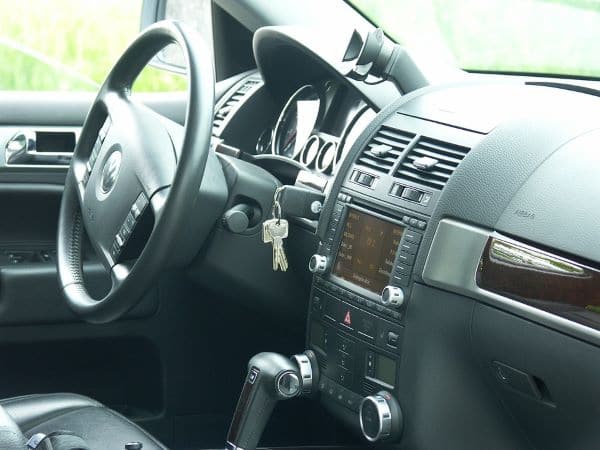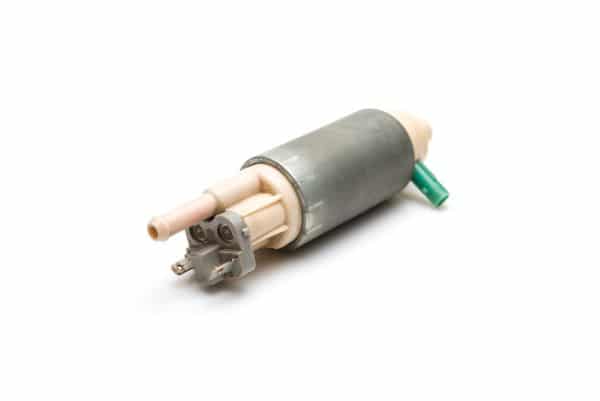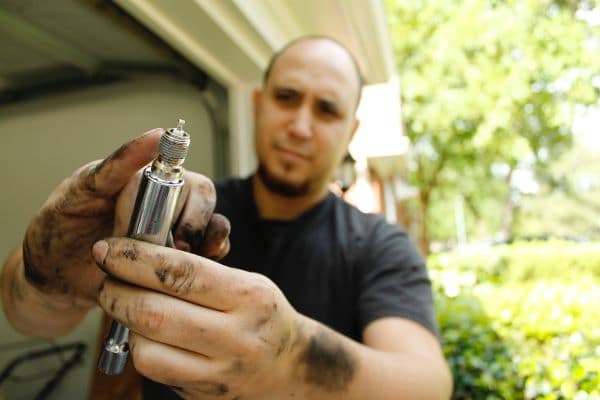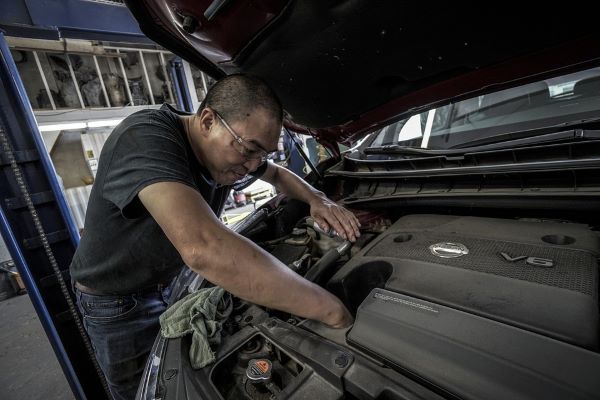When you get behind the wheel of your car, there are a lot of sounds that you could hear that cause alarm. One that is most disturbing is when the car turns over but won’t start. If the car cranks but won’t start, there are a lot of possible reasons. With a crank no start situation, you could be looking at a fuel system issue, ignition problem or something more severe.

When your car struggles to start, it’s important that you diagnose the issue early before larger problems occur. We evaluate some of the reasons why your car won’t start, so you can take charge of your transportation needs.
Table of Contents
Six Reasons Car Cranks But Won’t Start
In no particular order, we discuss the top causes when your car hesitates to start or you have a no start no crank situation.
1. Out of Fuel
If the car cranks but won’t start, it’s very possible that the vehicle is out of gas. Sadly, this happens more frequently than many drivers will admit. For the car engine to run the way it should, it needs compression, a spark and fuel.
Without fuel, the vehicle might crank offer but only sputter instead of start. Thankfully, this is an easy problem to troubleshoot and fix.
How to Tell if Vehicle is Out of Fuel
If you have a working fuel gauge, you should know if you are out of fuel. Right up until the point where you ran out, the car might have been sputtering and performing poorly, which is a result of fuel starvation.
If you don’t have a working fuel gauge, you would need to put some fuel in the tank to see if that is the problem.
What to Do Next?
If your vehicle is out of fuel, you need to fill it up. You can either walk to the nearest fueling station, have someone give you a ride or call for roadside assistance. Either way, once fuel is added, you should be good to go.
2. Faulty Ignition Switch
If the car takes longer to start or won’t turn over at all, it could be due to the ignition switch. In many cases, this problem will create a clicking or cranking sound when you attempt to start the engine.
The ignition switch activates the electrical system to start the vehicle. It’s the beginning of a domino effect of events that get you on the road. When the ignition switch goes bad, it affects the entire system.
How to Tell if the Ignition Switch is Bad
Testing the ignition switch isn’t complicated. In many cases, you can follow these steps.
- Turn off the ignition switch and disconnect the wire connector.
- Locate the starter solenoid S terminal and detach it.
- Turn the ignition key and place it in the RUN setting.
- Test voltage on the ignition coil’s battery terminal with a test light.
- Turn the switch to START and connect the white wire of the module to test voltage.
- If there is no voltage, you have a faulty ignition switch.
What to Do Next?
If the car takes a while to start because of a failing ignition switch, you want to have it replaced before you are left stranded. In general, a new ignition switch might cost you about $75, while the labor could be between $50 and $250. It’s not a complicated job, so you might be able to replace it yourself.
3. Dying Fuel Pump
If the car starts but won’t stay running, you might also have a problem with the fuel pump. When the pump fails, corrodes or becomes old, it gets harder to pull the necessary gasoline into the engine. If the fuel isn’t being delivered properly, the motor can’t run properly.

With this problem, you might also hear some whining noises coming from the tank as the pump begins to fail. As the situation gets worse, you will have a car turning over but not starting. Ideally, you want to resolve this problem before it fails completely.
How to Tell if the Fuel Pump is Bad
When the fuel pump is failing, you will notice several other symptoms other than the car cranks but won’t start. Here are a few of the other common symptoms.
- Noise from the fuel tank
- Engine sputters
- Engine stalls
- Loss of power and acceleration, especially under heavy loads
What to Do Next?
Fuel pumps can be a little more costly to replace. Expect to pay between $75 and $900 for the fuel pump, depending what kind of vehicle you drive. On top of that, you will be responsible for labor charges that might cost between $100 and $300.
4. Fuel Line Trouble
If a fuel line becomes frozen, you have some problems on your hand. This is a common problem in cold climates. With a frozen section of line, the fuel cannot travel to the engine, resulting in starvation.
Additionally, you could simply be looking at a problem with one of the fuel lines that is keeping gas from getting to the engine. If the lines are cracked or worn, there could also be fuel leaks.
How to Tell if a Fuel Line is Frozen
When a fuel line freezes, there are some significant symptoms you can look at.
- Car cranks but won’t start
- Engine sputters
- Engine starts but stalls or stops shortly after
What to Do Next?
If you can push the vehicle into a warm garage and leave it there for a few hours, the lines might thaw on their own. If you don’t have a garage, consider covering the engine with a blanket or putting a drop light over the area. Even if the lines thaw a little, you should be able to get fuel running through them again.
Once the car starts back up, keep it running for a little. When the engine sputters, give it a little gas.
You can also try some fuel additives that are meant to thaw lines. Some of these products only take 20 minutes to work.
As a preventative measure, make sure you keep your gas tank full in cold months. Excessive amounts of air make it easier for the lines to freeze. You should also park in a garage when possible.
5. Worn Spark Plugs
If the car struggles to start but runs fine or you can’t get it to run at all, the spark plugs might be to blame. In general, you shouldn’t need to change the plugs that often, but they do go bad.

If the plugs are fouled, the spark needed for combustion won’t be present, causing trouble when it comes time to ignite the air and fuel mixture.
How to Tell if Spark Plugs are Worn
You can start by doing a visual inspection of the spark plugs. Look at the tip for signs of wear or compare the old set to a newer one. If there is any contamination of the plugs, you might have bigger issues that need to be resolved.
What to Do Next?
The only way to repair bad spark plugs is to replace them. If you are using copper plugs, you should perform a tune-up every 30,000 miles on average. Otherwise, you might be able to go 100,000 miles before you need to replace the plugs.
For the low cost of spark plugs replacement, you should never avoid a tune-up. Running the engine with defective plugs can cause the catalytic converter to go bad, which creates a very expensive repair bill.
6. Technology is Your Enemy
Your modern vehicle is filled with some great technology that gives you driving confidence. However, there are also times when the technology makes situations complicated.
For example, if there is a fault recognized somewhere in the system, the engine could go into a failsafe mode where you can’t start the engine. However, if the car cranks, you know there’s not an issue with the key fob or proximity key, as these would create a no-cranking situation if either were to go bad.
How to Tell if Technology is Causing Trouble
With an OBDII code scanner, you should be able to read trouble codes being sent by the computer. Once you have these codes, you will know what needs to be replaced.
What to Do Next?
Have the system scanned for codes and repair the problem. Once the engine realizes that everything is fixed, you should be able to start the engine again.
Troubleshooting Engine Cranks But Won’t Start
We’ve discussed a lot of reasons why the engine might not start, so how do you know what your problem is? The first step is to think about what happened last. For example, if the engine was sputtering before it quit, you might just be out of fuel. Otherwise, if the car overheated and won’t start but turns over, you could be looking at a mechanical issue.

Here are some steps you might want to take.
- Turn off the vehicle.
- Remove the air inlet tube on the throttle body.
- Spray a small amount of starting fluid in the engine and push the throttle open.
- Crank the engine.
- If it starts and dies right away, the compression and spark are good, but there is a fuel issue.
- If the engine doesn’t start, you probably have a spark issue.
Try not to repeatedly crank the engine or you could wear out the battery and starter. If you must continue to try, give the starter a break for 15 seconds in between.
FAQs
What causes no crank and no start?
If the engine won’t crank, you could have a dead battery. It’s also possible that the starter circuit has been damaged. You would have to measure the voltage with a multimeter.
What does it mean if my car won’t turn over but has power?
If the vehicle has power, there is probably nothing wrong with the battery or alternator. Otherwise, you will need to look at the variables that lead to engine compression, fuel delivery and spark. One of the components in these systems is likely causing your issue. Go through our checklist to see what the culprit might be.
Why do I have to turn the key multiple times to start a car?
In most cases, this signifies a fuel issue. Every time you turn the key, you prime the fuel system until it creates enough fuel delivery to start. The issue could be related to a dying fuel pump or a clogged fuel filter. Repair the failing part before you are left stranded.
Conclusion
While it can be scary when the car turns over but won’t start, you have the power to resolve the situation quickly. With a little troubleshooting and by paying attention to the symptoms, you don’t have to be stuck with a dead car. Work through our list of solutions to see what’s causing your problems and get it repaired before you face bigger issues with more costly repair bills.
